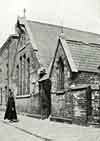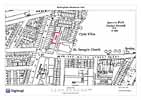For this church:    |
Nottingham St GeorgeHistory
St George’s Church was founded as a chapel (of ease) of St. Saviour’s Church. It was preceded by a mission building erected in 1870 on Launder Street by the latter and known as St. Augustine’s Mission. It was located on the newly developed meadow land to the west of St. Saviour’s to meet the needs of the growing town of Nottingham. By the mid-1880s it was recognised that the mission building was no longer large enough to accommodate the congregation, and plans to build a more substantial building were drawn up. The design work was undertaken by local architect R. C. Sutton and the construction contract awarded to a local building firm, Hudson & Sons of Meadow Road. Work commenced in 1886 on St. Augustine’s Street, a short distance from St. Augustine’s Mission. The foundations and the lower part of the walls were completed and the foundation stone (west wall) laid on 1 July 1887 by Henry Smith Wright, MP. The building was completed and licensed as a place of worship on 12 June 1888. In 1891 St. George’s was consecrated as a chapel of ease to St Saviour’s; the dedication to St George, rather than St Augustine, was to avoid confusion with existing churches in New Basford and on Woodborough Road. At this time St. Augustine’s Mission was still active, and both were funded by St. Saviour’s. The new building cost £7,032 and had seating for 520; St. Augustine’s Mission could accommodate 250.
The westward expansion of the city along the banks of the River Trent resulted in a rapid increase of incomers, and in 1892 St. George’s was designated a District Chapelry. Within a few years several mission buildings were founded to serve the parish needs. The first of these was in 1895 with the opening of St. George’s Day School, with Miss L.A. Bowler as Headmistress, a post she held until 1930. The school was closed in the same year, but another school was operating in Launder St. This was quickly followed by building of the Meadows Hall Trust Mission, St. Augustine’s Mission appears to have closed by this time. Just a year later in 1897 St Wilfred’s Mission, a small wood framed and wood clad building surrounded by terraced housing, was opened close to the river on Briar Street. In 1902 the church records first mention the existence of St Aidan’s Mission on Middle Furlong Road, stating that the debt incurred had been paid off. At some later point St. Aidan’s must have been closed because a note of 1907 records that it was reopened. At the turn of the century the parish population was recorded as 8,278. In 1901 a day school for infants was added to the growing list of St. George’s services to the community. It could accommodate only 200 pupils, rather less than the 300 registered at the Sunday School. By 1904 St George’s had a capacity of 450 seats and St. Wilfred’s 100, with Sunday School attendance at St. George’s also 450. Meadows Hall Mission had 184 girls and 110 boys on the register. St. Aidan’s Mission on Middle Furlong Road was attracting just 32 Sunday school scholars. This was the most westerly point of the parish and was originally extra-parochial land which was part of the Nottingham Castle estate. To manage the Sunday Schools some 260 Sunday School teachers were in post. A range of other attractions were provided by the church including a library and a choir with 70 members. St George’s held three Sunday and two weekday services, and six services on Easter Day. In 1907, 198 infants were recorded as being baptized, and one adult. The implication of building St. George’s on flat meadow land adjacent to a major river was evident in 1910, when the river burst its banks, rendering the church inaccessible for three days due to the area being flooded. This problem has been repeated several times since 1932. In 1911 the Bishop of Southwell asked the Society of the Sacred Mission based at Kelham Hall to take charge of the parish, an arrangement which continued until 1982. Often several priests were attached to St. George’s, living in a priory house located on nearby Launder Street. Sisters from the Convent of St. Peter, Horsham, also served the parish, working as Lady visitors. Since 1911 the St. George’s congregation has followed the Anglo-Catholic style of worship. Records for 1911 also show that the parish population was reduced by nearly 800; this may have been due to the opening in 1899 of a mission by Saviour’s Church (St. Faith’s Church from 1904) to the south of St George’s and the transfer on an unknown date of St. Wilfred’s Mission to St. Faith’s. St. Wilfred’s was returned to St. George’s in 1914. This was the same year that the final addition to the church, the building of the south porch, was completed. Despite the onset of World War I, in 1914 plans were prepared for the completion of the Lady Chapel. It was completed at a cost of £750, funded by a loan, and dedicated in 1915 by the Bishop of Southwell. In 1920 subscription fundraising was begun for a memorial to the fallen of World War I. A Portland stone Calvary was unveiled by Sir Henry Bentinck in June 1921. St. George’s appears to have been a socially active church. During the Miner’s Strike of 1926 the Meadow Hall was utilised as a soup kitchen for miners and their families, and again in the Great Strike of 1929 when TUC marchers on the way to London were welcomed to sleep in the Meadows Hall. In the depression of the 1930s two rooms were made available in the old school on Launder Street for the use of the unemployed. Church premises were utilised for a Senior Boys’ Club, Senior Girls’ Club, Junior Girls’ Club, Junior Boys’ Club, Mothers’ Union, Guild of St. Agnes for Ladies, and The Fellowship of St. Paul for Men. In 1936 the Launder Street premises were closed, but the Meadows Hall was improved and presumably the groups transferred. By 1938 the parish population had reached 20,000, which increased steadily until the 1960s when Nottingham City Council embarked on a major redevelopment of The Meadows area. The housing, community, and most of its support structures and facilities were swept away by the demolition teams and the land temporarily lay barren until rebuilding commenced. St. George’s Church was spared to continue its work, providing a reminder of the past and standing as a beacon for the future. | |||||








